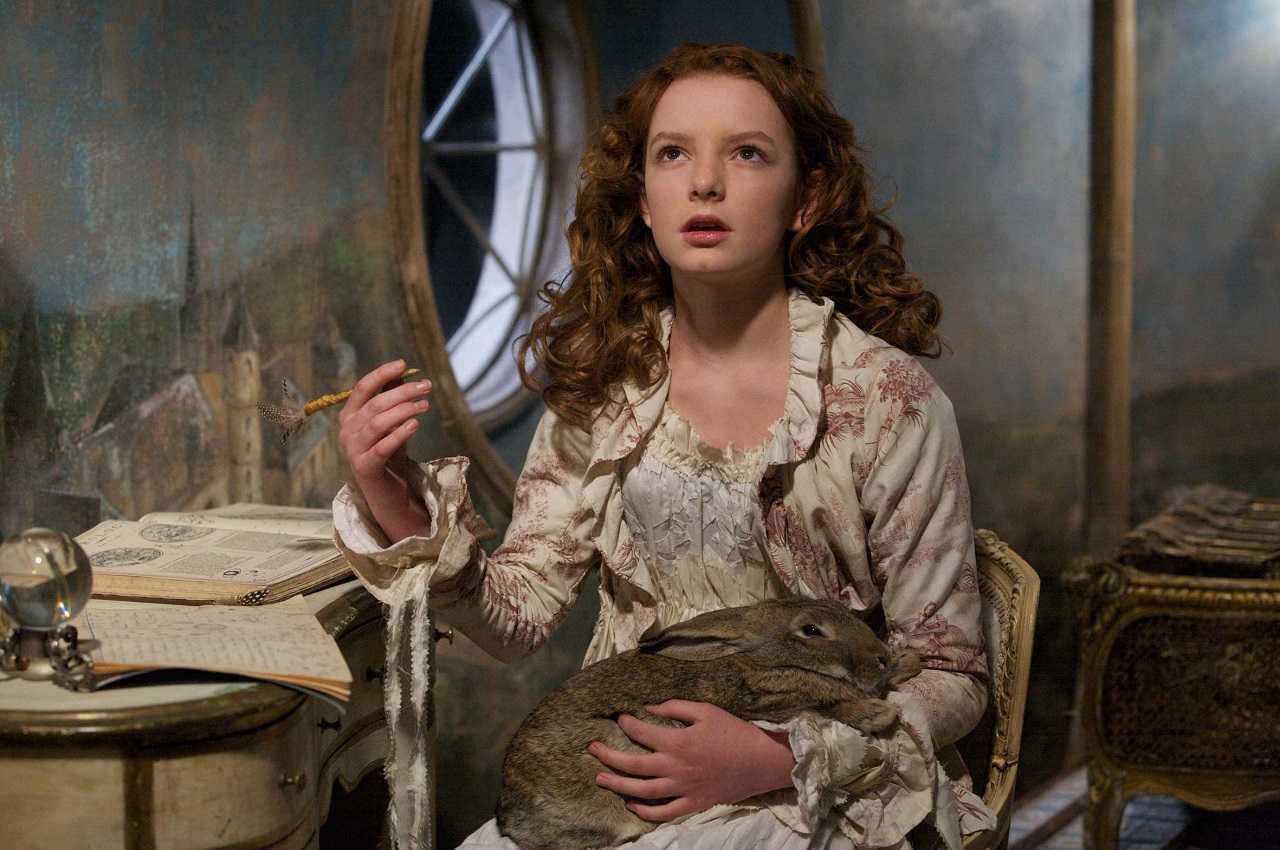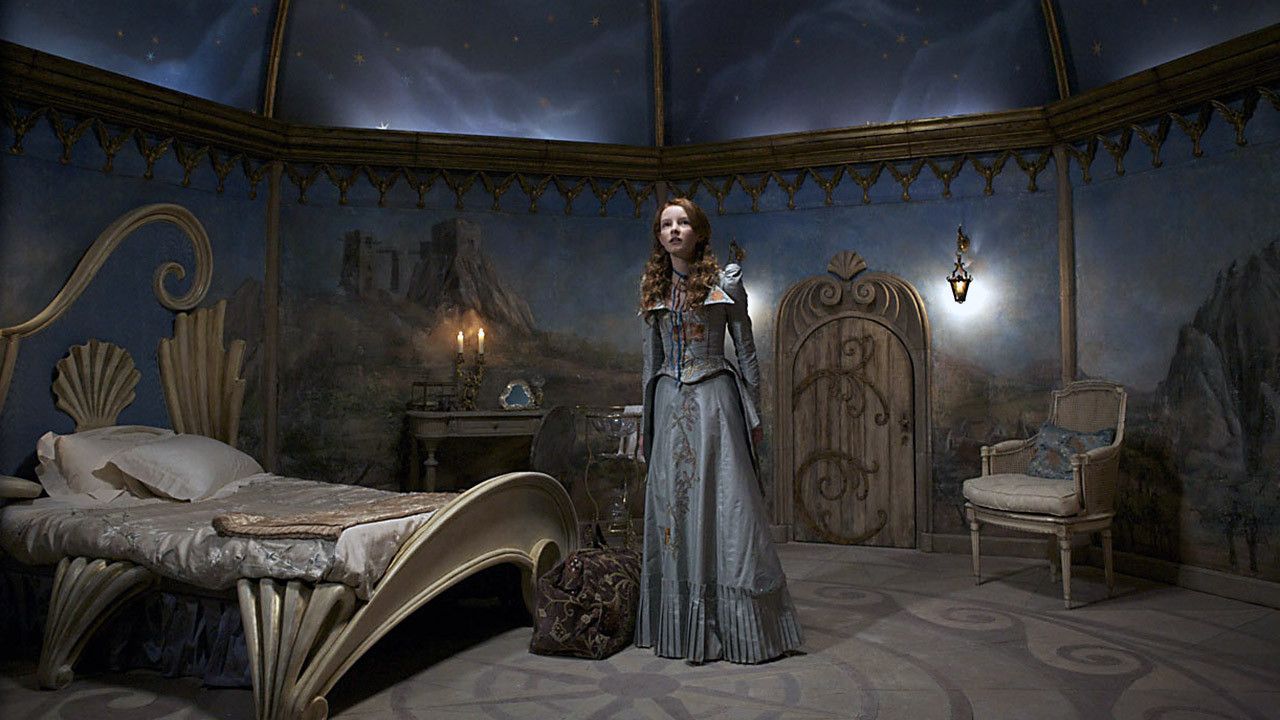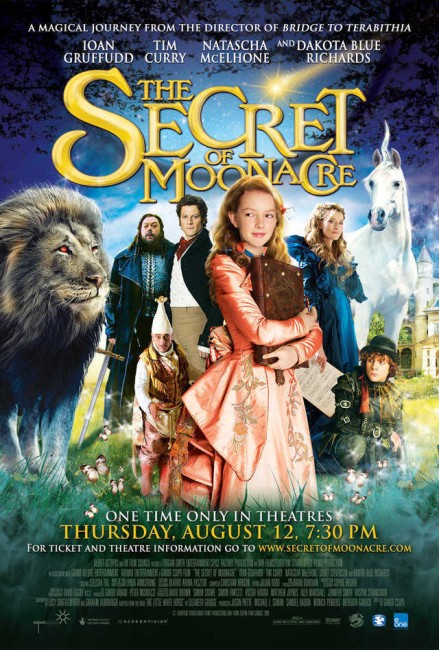USA/UK/Hungary/France. 2008.
Crew
Director – Gabor Csupo, Screenplay – Graham Alborough & Lucy Shuttleworth, Based on the Novel The Little White Horse by Elizabeth Goudge, Producers – Michael Lionello Cowan, Meredith Garlick, Monica Penders, Jason Piette & Samuel Hadida, Photography – David Eggby, Music – Christian Henson, Visual Effects Supervisor – Sean Farrow, Special Effects Supervisor – Ferenc Kardos, Production Design – Sophie Becher. Production Company – Spice Factory/Metropolitan Filmexport/Eurofilm Studio/Forgan-Smith Entertainment/Grand Allure Entertainment/The UK Film Council.
Cast
Dakota Blue Richards (Maria Merryweather), Ioan Gruffudd (Sir Benjamin Merryweather/Sir Wrolf Merryweather), Natascha McElhone (Loveday/Moon Princess), Juliet Stevenson (Miss Heliotrope), Tim Curry (Coeur De Noir), Augustus Prew (Robin De Noir), Andy Linden (Marmaduke Scarlet), Michael Webber (Digweed)
Plot
After the death of thirteen year-old Maria Merryweather’s father, she is shocked to learn that all of his money has been consumed by debts. Maria and her tutor Miss Heliotrope are forced to leave their home and seek refuge with Maria’s uncle Sir Benjamin who lives on the forbidding Moonacre estate. All that is left to Maria in her father’s will is an illustrated book that tells the history of the Merryweather family and their rivals the De Noirs. From among the De Noirs came the Moon Princess who was beloved by nature. She had been gifted a set of pearls that showed the truth in people’s hearts. She was to marry Sir Wrolf Merryweather but the two families came to conflict with each desiring to use the pearls for their own purposes. The Moon Princess then placed a curse on the two families that would last for the next 5000 moons. As they arrive at Moonacre, Sir Benjamin proves rude and curt, including confiscating the book to Maria’s upset. Maria soon finds mysterious things happening around the estate – delicious meals are left for them despite their being no cooks or servants; the fierce dog Wrolf becomes her protector; and a mysterious white horse can be seen on the grounds. Sir Benjamin gives dire warnings that Maria never go into the woods. When she disobeys these, she finds herself threatened and then abducted by the De Noirs. With the help of the hermit Loveday, Maria comes to discover a series of clues. These show that Maria is the incarnation of the Moon Princess, returned after 5000 moons to find the secret hiding place of the pearls and unite the two families from their centuries old curse.
Director Gabor Csupo first emerged with the animation company Klasky-Csupo Productions. Klasky-Csupo produced the animation for the first few seasons of The Simpsons (1989– ) – indeed Klasky-Csupo animated The Simpsons through their first incarnation on The Tracey Ullman Show (1987-90). Klasky-Csupo then went on as producers/creators of animated shows like Rugrats (1991-2004) and The Wild Thornberrys (1998-2001), as well as various film spinoffs from these. Csupo made his debut as a live-action director with the children’s film Bridge to Terabithia (2007). The Secret of Moonacre was his second film and he has subsequently went on to direct the animated Immigrants (La Dolce Vita) (2008) and the live-action Hungarian comedy Pappa Pia (2017).
With The Secret of Moonacre, Csupo turns to The Little White Horse (1946), an acclaimed children’s book by British writer Elizabeth Goudge. I have not read the original but apparently the film takes some liberties while remaining generally faithful to the narrative. As such, The Secret of Moonacre falls into a certain species of children’s films that are set among the imagined glow of Victorian or Edwardian England – see the likes of Mary Poppins (1964), Chitty Chitty Bang Bang (1968), The Wolves of Willoughby Chase (1989), The Secret Garden (1993), A Little Princess (1995), Peter Pan (2003), Five Children and It (2004) and The Chronicles of Narnia: The Lion, The Witch and the Wardrobe (2005). It is a setting that seems to hold an undeniable purity – where childhood is part of an undeniable class setting, where parents wield benevolent authority rather than are seen as amiable schmucks, where fantasy doesn’t come polluted by modern pop culture and knowing cynicism, and where the appearance of the magical holds something amazing that transforms the formality and rigidity of society with childlike delight.
The problem that Gabor Csupo was faced with in Bridge to Terabithia was being caught between conflicting sets of influences, each of which were pushing the film in a different direction. There was Disney who were clearly wanting to make it into another Lord of the Rings or The Lion, The Witch and the Wardrobe, which mandated the addition of creature effects in the woods, even though Terabithia was not an epic fantasy type film and could easily have worked without them. Elsewhere, the Christian-backed Walden Media seemed to be wanting to use the film to promote the Gospel message. In the midst of this was Csupo who seemed to be wanting to make a children’s film that was grounded in a non-sentimental reality and say something about how children dealt with tragedy. Not understandably, caught between these influences, Bridge to Terabithia emerged as confused.

The good news is that The Secret of Moonacre is a substantial improvement over Bridge to Terabithia. Gabor Csupo pitches his fantasy with near-flawless regard. He does an outstanding effort of establishing the forbidding world of the estate that young Maria is cast into and then leavening it with magical touches – the discovery of a kitchen/garden inhabited by a strange gnome of a man who may have magical powers; the dog with glowing red eyes that momentarily appears to be the black lion from the book when seen in the mirror; the appearance of a unicorn.
The most magical image is the one that comes at the end (which has surely been conceived as a live-action/CGI version of the climax of The Last Unicorn (1982) or perhaps the scene in The Lord of the Rings: The Fellowship of the Ring (2001) at the Ford of Bruinen) – where Dakota Blue Richards dives into the ocean with the pearls and then her body is lifted back up by waves that become white horses carrying her before dissolving to foam once they hit the sand.
The production design team do a positively edible job – Dakota Blue Richards sleeps in a bedroom with walls painted deep sky blue and covered with stars, fireplaces shaped like curlicues and a glass dome ceiling that looks up on the night sky; and some equally good sets of the De Noir castle in ruins and the depths of its dungeons. The design schema is a mixture of exquisitely rich and colourful sets and in particular costumes, which gain even more colour when contrasted against the austere surroundings of the Moonacre estate. There is also a beautiful period score.

Dakota Blue Richards, previously Lyra Belacqua in The Golden Compass (2007), gives a fair and reasonable performance as Maria. An alternately dashing and curtly rude Ioan Gruffudd could be a perfect incarnation of a 19th Century romantic anti-hero like Mr Darcy or Heathcliff.
The Secret of Moonacre is not entirely perfect. The De Noirs are too much stock villains – all in capes, warlike costumes and armour – which is something that, given such a caricature treatment, mitigates against their eventual redemption at the end ie. you have difficulty seeing Tim Curry as redeemed when he is still standing there in his black villain’s cape. The focus on romantic redemption and pride is a little too modernistic than would have been the case for a British children’s novel of its era, but you cannot deny that Gabor Csupo has created a fine film.
Disappointingly for such a beautiful film, it received a sporadic and spotty distribution – it, for instance, only screened limited theatrical release in the US over two years after its original premiere. It deserved a good deal better, especially when compared to the bland fodder cluttering up holiday season screens.
(Nominee for Best Production Design at this site’s Best of 2008 Awards).
Trailer here

